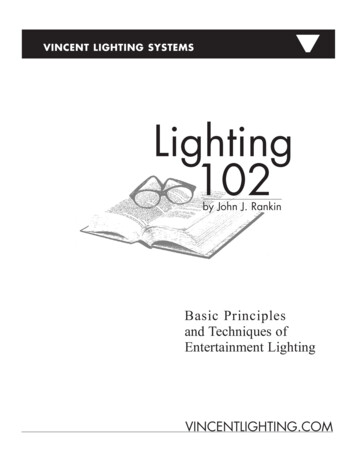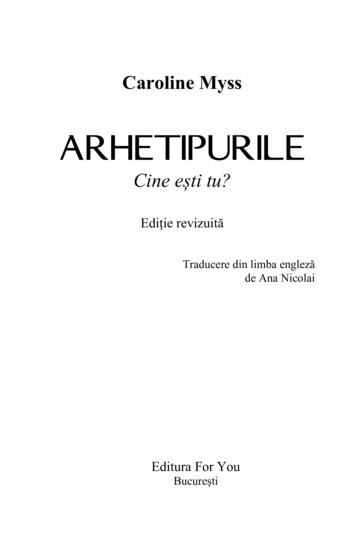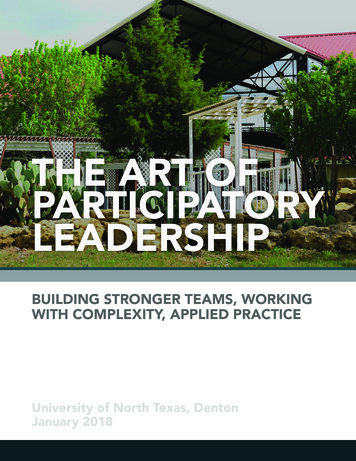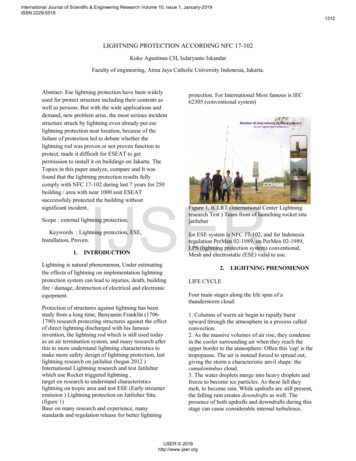
Transcription
VINCENT LIGHTING SYSTEMSLighting102by John J. RankinBasic Principlesand Techniques ofEntertainment LightingVINCENTLIGHTING.COM
This guide is intended to provide a very basic understanding of entertainment lighting. It is intended to be a learning tool and is in no waymeant to be a substitute for formal training in lighting and electronics.
IntroductionThe field of entertainment lighting was once limited to theater, film andtelevision, but has grown to include retail display, photography, education, worship services, corporate events and trade shows. This article will provide some ofthe basic principles and techniques of entertainment lighting. We refer to entertainment or stage lighting in general terms, to pertain to the varied applicationsmentioned above. Of course, there is more than one way to approach entertainment lighting. However, what follows is basic lighting theory and practice that isrecognized by our industry.Vincent Lighting Systems is a team of dedicated professionals whose mission is to provide lighting solutions. We love the opportunity to create magic withlight and hope others share our passion. If you have further specialized questions,please contact us for answers.3
Functions of Stage LightingThe following criteria should be used to determine if stage lighting is necessary and effective.1. VisibilityVisibility is a very important function of stage lighting. The audience should be able to seeexactly what you want them to see, or not see those things that should remain hidden.Therefore, we might rename this function as “selective visibility.”An example of selective visibility can be found in the play, Wait Until Dark by FrederickKnott. A blind woman is terrorized by a murderer hiding in her apartment. To even her oddsagainst him, she smashes all of the light bulbs thus plunging him - and the audience - intodarkness. The action is revealed verbally and occasionally visually with flashlights, matches,and a very surprising source of light at the climax of the play.2. Revelation of FormSimilar to selective visibility, revealing the form of the actor, dancer, or speaker will makethem stand out from their background. Using techniques described later in this article, youwill be able to make the subject appear natural and be the focus of attention for the viewers.For example, when lighting a ballet it is important for the stage lighting to reveal the form ofthe dancers. The audience wishes to see the dancers move through the space and stand apartfrom the background. Lighting ballet has been described as “lighting fish in an aquarium.”Light is the same as water in this metaphor. The lighting designer creates an “environment”for the dancer to move through.3. Placing the ActionThe stage lighting can be effectively used to represent the location of your presentation. Doesthe action take place inside or outside? At day or night? At dusk in a garden or at dawn inManhattan? The lighting can be instrumental in establishing time and place.4. MoodAre you staging a “light” comedy or a “dark” drama? These metaphors are used on purposeto make the point that stage lighting can help provide the mood for your event. Comedies areoften bright and cheery. Dramas may be darker with shadows.5. CompositionPerhaps today more than ever before, stage lighting can be used to compose a picture. Someevents contain little or no scenery and use lighting to create the overall picture of the scene.Musical concerts can be an example of this function.4
6. Reinforcing the StoryTwo examples follow of how lighting can reinforce the story being told:Late at night after partying with friends, an infatuated Romeo sneaks into Juliet’s garden,hoping to catch a glimpse of her. Juliet enters from above, on her garden balcony. Romeosays, “But soft, what light through yonder window breaks? It is the east and Juliet is thesun!”Scene 9 of Tennessee Williams’ play A Streetcar Named Desire: An angry Mitch confrontsBlanche about her lies and questionable past. Mitch says, “I don't think I ever seen you inthe light You never want to go out till after six and then it’s always some place that’s notlighted much I’ve never had a real good look at you Blanche. Let’s turn the light on here.”Blanche says fearfully, “Light? Which light? What for?” Mitch: “This one with the paper[lantern] on it.” He tears the paper lantern off the bare light bulb hanging from the ceiling.He then switches on the light bulb. Blanche utters a frightened gasp Certainly these classic works of literature would still be excellent if performed in a hangarunder fluorescent lights. But, in a controlled stage production, the lighting can help reinforcethe story.We can likely come up with other functions or dissect those listed above. If you use thesefunctions in the proper proportion for your needs, you will have a successful lighting design.The Qualities of LightWe have described six functions of stage lighting. Next, we need to define some of the qualitiesused to describe light.1. IntensityLight has intensity and can be described as bright or dim. The intensity can be adjustedusing equipment which will be described later.2. ColorLight also has color. How many colors are evident in a sunset? Many to be sure. What coloris light from candles with no electric lighting? What color is sunlight at dawn? Answers tothese questions and your decisions about color are often very personal and subjective. If youare designing Romeo and Juliet, what color is the sunlight coming through their bedroomwindow on the morning after their secret wedding? Or, what color does the “envious moon”in Juliet’s garden cast? A discussion on tools for coloring light, and suggestions for thebeginner will follow.3. DistributionDistribution describes the direction of the light (or lack of direction if it is soft and diffused).The distribution of stage lighting is represented differently on stage whether it is direct sunlight, a living room or a castle’s dungeon.5
4. MovementDoes light have movement? Sure, and we’re not talking about lights that pan and tilt.Imagine how the stage lighting “moves” at the end of Act I of the opera Madame Butterflyby Puccini. Cio-Cio-San (Madama Butterfly) confesses to Pinkerton (her bridegroom) thatyesterday, alone and in secret, she climbed the hill up to the Mission as she adopted the religion of her bridegroom. With the wedding ceremony completed, the guests toast the couple.The atmosphere is very happy and bright. Suddenly Cio-Cio-San’s uncle, the Bonze (aJapanese priest) bursts upon the scene with her extended family, cursing the girl for havingrenounced her ancestors’ religion. Pinkerton furiously orders the Bonze and family to leave.Alone at last with his bride, Pinkerton reassures Cio-Cio-San and dries her tears. As theystand in the moonlit garden gazing at the stars, they discover their love for each other. Thefamiliar and beautiful love duet Viene la sera (“Evening is falling”) ends Act One.The lighting can be described as moving, or progressing, from afternoon, when it is happyand bright; to dusk with an orange sunset during the Bonze’s scene; to a romantic moonlitgarden.Stage Lighting PlacementAs the lighting designer, you can define goals by choosing which qualities and functions oflighting you wish to accomplish in your design. How do you accomplish your goals? We willfirst describe a method for lighting fixture placement.The most common method for lighting a stage iscalled the McCandless System. StanleyMcCandless wrote about this method in his1932 book, A Method of Lighting the Stage. Hismethod was not meant to be the definitive method, but it is a useful system based on his experience.The method can be described as a 3-point system. Two lighting fixtures are placed in the frontof the subject and one fixture behind. The frontlights are located at a 45-degree angle to the leftand right of the subject and at a height equal toan angle of 45-degrees above the subject. Theselocations make the subject appear natural and have 3-dimensional form. The shadows causedby the angles of the light provide definition of form without causing deep, dark shadows underthe eyebrows, nose, or chin. The location and angle also provide visibility as the subject turnshis/her head from side to side.6
Color and intensity added to the front lightswill provide visibility and definition.McCandless recommended using a warmcolor in one front light, and a cool color in theother. The colors blend for a natural appearance and contrast with each other to providedefinition.The third light is to be placed behind and highoverhead the subject, without being directlyover the subject or shining in the audience’seyes. The “backlight” causes the subject tostand out from the background and furtherdefines his/her form by lighting the back of the head and top of the shoulders. The color of thebacklight depends on your intentions. Usually you are “coloring the shadows” cast by the frontlights. However, you may want to create a halo effect by using intense, warm backlight.“Do I need more than three fixtures?” Yes, unless your subject is a speaker at a podium, nevermoves, or doesn’t have a background to be lighted. Based on the typical lighting fixtures andauditorium heights, you should consider the areacovered by a single three-point group of fixtures tobe eight feet in diameter. Therefore, you will needseveral fixtures placed at eight-foot intervals tocover your entire stage or platform. If this area is25 feet by 25 feet, you may have nine “actingareas” of eight-foot diameters. This represents anideal scenario of equipment and space. The realitiesare not often ideal.This lighting design will provide basic illuminationfor your stage or platform. If you require more colors or more angles, you may have to double or triple the number of fixtures focused on one actingarea. Examples would be needing in one event bothday and night; different locations; or perhaps entirely different productions during the same event. Your blue back lighting may be great forJuliet’s garden, but bad for a hot summer day in the streets of Verona (Juliet’s home town).Additional lighting will be required to light a background, drapery or scenery; and to provide“specials,” which highlight a specific area or action not covered by the general “area” lighting.7
Controlling the Color of StageLightingWe learned in school that the primary colors of pigment are red, blue andyellow. Mix these together in the right combination to create any color.Mix them all together to get black.Light also has primary colors, however, they are different. Mix red, blue orgreen light to create any color. Mix all three together and you’ll get whitelight (not black). The physical properties of light and color are beyond thescope of this article. Excellent books on the science and art of lighting canbe found in the recommended reading section at the end of this guide.Stage lighting is usually colored by placing a thin sheet of plastic in front of the lens. Thesesheets are called “color filters,” or “gel” because they were originally made of dyed animal gelatin. Modern gel has a polymer base of acetate, vinyl, polyester or polycarbonate. Stage lighting fixtures produce very high temperatures and the light filtered by the gel is converted to heat.Therefore, do not use anything except color filters designed for use in entertainment lighting.Gels come in hundreds of colors/hues and the use of color is very subjective. However, if youare a novice and need some advice, we recommend the following colors to get you started:ColorManufacturer Name/Gel NumberWarm front light:Bastard AmberRoscolux 02Lee 162Apollo 7050Cool front light:Special LavenderRoscolux 54Lee 702Apollo 3350Back light:Daylight BlueRoscolux 65Lee 196Apollo 4500Background lighting:Light RedRoscolux 26Lee 026Apollo 8300Primary BlueRoscolux 80Lee 079Apollo 4250Primary GreenRoscolux 91Lee 139Apollo 5300Additionally, there are color filters made for video and photography designed to balance thecolors of different light sources, or “correct” the color of an artificial light to make it appear asdaylight by the camera. These filters are called color correction filters. “Diffusion” or “silks”are filters used to soften the hard-edge of the beam of light to varying degrees.8
Controlling the Intensity ofStage LightingThe most common way to control the intensity of stage lighting is by an electrical dimmer.Stage dimmers have more electrical capacity than household dimmers. They are usuallyarranged in equipment racks, and the racks are placed in a mechanical room, isolated from theperformance area due to the heat and noise generated by the cooling fans.Smaller, portable dimmers can be placed right next to the light fixture.In a modern dimming system there is one dimmer for each electrical outlet.Outlets are distributed throughout the performance space in every possible location you may want to place a light fixture. However, it is better to place the fixtures as needed for your event rather than place a fixture in each outlet. Flexibilityis the key to a successful installation.Whether the dimmers are in a mechanical room or next to the fixture, they arecontrolled remotely. The dimmers are connected with Dimmer Rack:a low-voltage, digital control wire to a tabletop con- Strand Lighting C21with up to (96)trol console. The operator of the control console will 2400-watt dimmersprogram or otherwise operate the console to controlindividual dimmers or groups of dimmers. The entertainmentindustry standard for the control signal is called “DMX.” The dimmers can also be controlled by various styles of architectural wallControl Console: Strand Lightingstations when you don’t wish to use your main console.PresetPaletteLighting FixturesEllipsoidal Reflector Spotlight (ERS)Trade names: Leko, Source Four, SLThe ERS is a fixture with an elliptical-shaped reflector to gather and directlight from a single-point source. The light is directed through a tube withone or more lenses. It provides a sharp circular beam of light. ERS areequipped with four internal shutters that allow the user to control the beamof light by shuttering off walls, scenery, etc. ERS are most commonly usedfor projecting medium to long distances. Wattage is typically 575 watts, butcan range from 375 watts to 1000 watts.Ellipsoidal: Strand SLBecause they have a lens, the ERS is also used to project patternsand images, called “gobos.” Gobos may be stainless steel or glass.Hundreds of standard images and patterns are available, as well ascustom patterns made to order.Steel Pattern or“gobo”9
Fresnel SpotlightPronounced [frə-'nel], this fixture is named for the man who invented the shape of the lens,which was originally used in lighthouses. The fresnel has a small parabolic reflector to directlight out of the front of the fixture and through the fresnel lens. Like the ERS, the fresnelproduces a circular beam of light, but it is soft and not as easily controlled.Only the size of the pool of light can be adjusted on the fresnel. A fresnel isdescribed in “spot” focus if the pool is zoomed to a small diameter. Thefresnel is in “flood” focus if the pool of light is zoomed out to a largerdiameter.Fresnels are typically used for short to medium throw distances. Typical wattages range from 500 watts to 2000 watts, however, 5,000 to 10,000 watts isnot unusual for film/video production in large studio spaces.By adding a “barndoor” accessory to the front of the fixture, you can blocklight off of scenery and walls.Strand 6” FresnelPAR FloodlightPARs or PAR Cans were developed as the staple of the rock and roll lightingindustry. They are light, rugged, easy to use, and produce a great deal of light.The PAR fixture is essentially a hollow tube with a lamp socket. The lamp consists of a parabolic aluminum reflector (thus PAR) with a lens attached to thereflector. The lamp resembles the traditional auto headlamp. PAR lamps arechosen based on their wattage and beam spread of the lens, from narrow towide.PAR fixtures produce an oval beam pattern. The only adjustments to the beamare made by rotating the entire lamp inside the fixture, thus rotating the ovalpattern. You can also adjust the beam by changing the beam spread of the lampwith a different lamp.Altman PAR 64 FixturePARs are typically used for back lighting or lighting from the sides. They arealso used for front lighting where shaping the beam is not crucial. Barndoorscan be used to shutter extra light “spill” off walls and scenery.Star-Par or Source Four Par FloodlightTypical PAR lampsThese fixtures are the next generation of PARs. They use the more efficient ERSlamps and have interchangeable lenses to vary the beam spread. Typical wattagesare 575 or 750 watts. Use these fixtures as you would traditional PARs.Altman StarPar10
Striplights, Borderlights, Cyc Lights, and Ground RowsLighting & Electronics 6560 BorderlightThese names describe several types of fixtures with multiple lamps, or “cells.” Theyare used to light a wide, flat area such as a backdrop, curtain, or as general lightingover a stage. Typically, the striplight contains 3 or 4 circuits, each circuit with a different gel color. By mixing the colors and intensities you can color the background orstage to your desired color. This is how a sky background changes from light blue toorange, then purple, then dark blue for night.The size and wattage of these fixtures varies depending on their application. Typical striplights are 500 or1000 watts for each cell. Typical borderlights use PAR38 lamps rated from 120 watts to 300 watts for eachcell. Vincent Lighting Systems can recommend the best fixture for your needs.FollowspotThe followspot is designed to spotlight performers in a bright pool of light which “follows”the performer around the stage. A person standing next to the followspot manually operatesit. The fixtures range from compact units for short distances and intimate settings, to largefixtures used in arenas and stadiums. Every auditorium should have at least one followspotfor spotlighting a solo performer.Selecon Toru FollowspotAutomated or Intelligent FixturesThese terms refer to fixtures containing electronics and motors onboard to vary theposition, color, and intensity of the beam of light. Some have onboard dimmers. Mostof them contain several “gobos” on a wheel and an “iris” for making the beam large orsmall. Automated fixtures also have a method of coloring the beam in pre-set colors orany color you desire.The fixtures come in two basic styles: “moving-yoke,” where motors control the panand tilt of the entire fixture; and “moving-mirror,” where a rotating mirroris mounted on the front of the fixture. As the mirror moves, so does thebeam of light.VARI*LITE VL500 Automated Fixture withmoving yokeThe functions of the fixtures are controlled by a “DMX” data signal fromthe main control console. They are used for “special effects” or placed inhard-to-reach locations where it is difficult to change color filters and aiming positions for everyshow. However, these fixtures do require routine maintenance and their lamps will eventuallyburn out, so they cannot be placed in a completely inaccessible location.High End Systems’Cyberlight Turbo Automated Fixture withmoving mirror.Once only utilized in large scale concerts, automated fixtures are now more affordable and easyto program, leading to their increased use in schools and community theaters.11
ConclusionIt is our hope that this article has provided you with basic information to use entertainment lighting to meetyour needs. Knowing the qualities and functions of lighting will help you choose how much equipment youneed and where to place it. The information on color, control and fixtures should enable the movement of yourdesign to heighten the viewers’ experience. Vincent Lighting Systems sells and rents lighting equipment,stocks theatrical supplies, and can provide experienced people to help with your design. If you are planning arenovation or new construction project, our outside sales staff can visit onsite to assist you with your planning.We Provide Lighting Solutions!Recommended ReadingScene Design and Stage LightingW. Oren Parker, R. Craig Wolf, and Dick BlockWadsworth Publishing; 8th edition (November 14, 2002)Stage LightingRichard PilbrowNick Hern Books (October 31, 1997)Lighting the Stage: Art & PracticeWillard F. BellmanBroadway Press; 3rd edition (February 2001)A Method of Lighting the StageStanley McCandlessTheatre Arts Books; 4th edition (June 1958)The Dramatic ImaginationRobert Edmund JonesRoutledge; 2nd Rev. Ed. (July 28, 2004)12
About the authorA native of Omaha, Nebraska, John J. Rankin (1961-2007) graduated from North Carolina Schoolof the Arts with a BFA. He worked for numerous regional theatre companies, includingYoungstown Playhouse and Playhouse in the Square in Memphis, Tennessee. In 1994, John washired as Project Manager for Vincent Lighting Systems. As the company expanded, he was promoted to Project Department Manager, overseeing the entire Project Department team. His keenanalytical mind and attention to detail allowed him to design and successfully manage the installation of manytheatrical lighting control systems around the Great Lakes region.About Vincent Lighting SystemsFounded in 1978, Vincent Lighting Systems (VLS) has full service offices in Cleveland, Cincinnati andPittsburgh. In addition, we have associated project sales offices in South Bend, Fort Wayne, Indianapolis,Evansville, Louisville, Columbus, Toledo, Grand Rapids and Saginaw. VLS provides theatrical, film/video andarchitectural lighting for a wide range of customers including performing arts centers, educational and religiousorganizations, production companies and retail establishments. The Company’s 50-person lighting team specializes in sales of products from over 100 manufacturers, as well as rentals and production services.Our years of experience, from design through installation, can be applied effectively to your project whether itis in a convention center, theatre, television studio, recital hall, sports arena, conference room, hotel ballroom,special event or remote film/video shoot.Our mission is to be the best theatre, film/video and architectural lighting company in the region. To accomplish this we work to fulfill our customers’ lighting needs and exceed their expectations. For systems, supplies,rentals and service, turn to Vincent Lighting Systems.CLEVELAND18370 South Miles RdCleveland, OH 44128tel 216.475.7600fax 216.475.63761.800.922.5356CINCINNATI1420 Jamike Ave #1Erlanger, KY 41018tel 859.525.2000fax 859.525.20501.800.356.5356PITTSBURGH920 Vista Park DrPittsburgh, PA 15205tel 412.788.5250fax 412.788.61151.800.877.5356Shop online at www.vincentlighting.comProudmember 2007 Vincent Lighting Systems. All Rights Reserved.
Excellent books on the science and art of lighting can be found in the recommended reading section at the end of this guide. Stage lighting is usually colored










